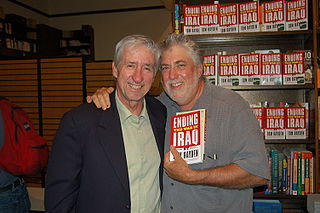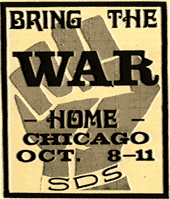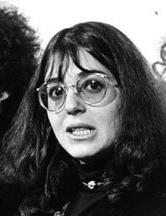
The Weather Underground was a far-left Marxist militant organization first active in 1969, founded on the Ann Arbor campus of the University of Michigan. Originally known as the Weathermen, the group was organized as a faction of Students for a Democratic Society (SDS) national leadership. Officially known as the Weather Underground Organization (WUO) beginning in 1970, the group's express political goal was to create a revolutionary party to overthrow the United States government, which WUO believed to be imperialist.

The Freedom Socialist Party is a left-wing socialist political party with a revolutionary feminist philosophy based in the United States. It views the struggles of women and minorities as part of the struggle of the working class. It emerged from a split in the United States Socialist Workers Party in 1966. The party's Seattle branch, with support from individuals in other cities, split off from the SWP over what it described as the SWP's entrenched opportunism and undemocratic methods. The party has branches and members in the United States, as well as Australia, England, Germany and New Zealand. The current National Secretary of the FSP is Doug Barnes.
The Seattle Liberation Front, or SLF, was a radical anti-Vietnam War movement, based in Seattle, Washington, in the United States. The group, founded by the University of Washington visiting philosophy professor and political activist Michael Lerner, carried out its protest activities from 1970 to 1971. The most famous members of the SLF were the "Seattle Seven," who were charged with "conspiracy to incite a riot" in the wake of a violent protest at a courthouse. The members of the Seattle Seven were Lerner, Michael Abeles, Jeff Dowd, Joe Kelly, Susan Stern, Roger Lippman and Charles Marshall III.

Bernardine Rae Dohrn is a retired American law professor and a former leader of the far-left militant organization Weather Underground in the United States. As a leader of the Weather Underground in the early 1970s, Dohrn was on the FBI's 10 Most Wanted list for several years. She remained a fugitive, even though she was removed from the list. After coming out of hiding in 1980, Dohrn pleaded guilty to misdemeanor charges of aggravated battery and bail jumping.

Mark William Rudd is an American political organizer, mathematics instructor, anti-war activist and counterculture icon who was involved with the Weather Underground in the 1960s.

The Days of Rage were a series of protests during three days in October 1969 in Chicago, organized by the emerging Weatherman faction of Students for a Democratic Society (SDS).

Susan Ellen (Tanenbaum) Stern was an American political activist. She was a member of the prominent anti-Vietnam War groups Students for a Democratic Society (SDS), Weatherman and the Seattle Liberation Front (SLF).

Cathlyn Platt Wilkerson, known as Cathy Wilkerson, is an American far-left radical who was a member of the 1970s radical group called the Weather Underground Organization (WUO). She came to the attention of the police when she was leaving the townhouse belonging to her father after it was destroyed by an explosion on March 6, 1970. Members of WUO had been constructing a nail bomb in the basement of the building, intending to use it in an attack on a non-commissioned officers dance at Fort Dix, New Jersey that night. Wilkerson, already free on bail for her involvement in the Chicago "Days of Rage" riots, avoided capture for 10 years. She surrendered in 1980 and pleaded guilty to unlawful possession of dynamite. She was sentenced to up to three years in prison and served 11 months.
Walter Charles Crowley was an American historian and activist from Washington state. He first entered the public sphere in Seattle through his involvement with the social and political movements of the 1960s, especially the underground press. He later became more widely known as a local television personality and for his pioneering work as a local historian, including co-creating the website HistoryLink.org, which he considered to be his crowning achievement.

The Helix was an American biweekly newspaper founded in 1967 after a series of organizational meetings held at the Free University of Seattle involving a large and eclectic group including Paul Dorpat, Tom Robbins and Lorenzo Milam A member of both the Underground Press Syndicate and the Liberation News Service, it published a total of 125 issues before folding on June 11, 1970.
Terry Robbins was an American far left activist, a key member of the Ohio Students for a Democratic Society, and one of the three Weathermen who died in the Greenwich Village townhouse explosion.

Laura Jane Whitehorn is an American activist who participated in the 1983 United States Senate bombing and was imprisoned for 14 years in federal prison. In the 1960s, she organized and participated in civil rights and anti-war movements.
Christopher Lynn "Kit" Bakke is an American activist. In the 1960s, she fought for women's rights and civil rights in addition to protesting the Vietnam War. In college, she helped to establish a new chapter of the Students for a Democratic Society (SDS). Later, she became a member of the Weathermen, also called the Weather Underground, a militant leftist group.

William Charles Ayers is an American retired professor and former militant organizer. In 1969, Ayers co-founded the far-left militant organization the Weather Underground, a revolutionary group that sought to overthrow what they viewed as American imperialism. During the 1960s and 1970s, the Weather Underground conducted a campaign of bombing public buildings in opposition to U.S. involvement in the Vietnam War. The bombings caused no fatalities, except for three members killed when one of the group's devices accidentally exploded. The FBI described the Weather Underground as a domestic terrorist group. Ayers was hunted as a fugitive for several years, until charges were dropped due to illegal actions by the FBI agents pursuing him and others.
Michael Justesen is a former member of Students for a Democratic Society (SDS), the Seattle Liberation Front (SLF) and Weather Underground Organization (WUO).
Jailbreaks were demonstrations staged by members of Weatherman during the summer and fall of 1969 in an effort to recruit high school and community college students to join their movement against the United States government and its policies.
Sabot was a brief-lived underground newspaper published in Seattle, Washington by the Seattle Liberation Front from September 11, 1970 to January 13, 1971. Sixteen weekly issues were published in all. The paper was started as a replacement for the Seattle Helix which had published its last issue in June 1970. As with its predecessor, Sabot was from the beginning torn by political dissension within the radical political collective, centering on an internal struggle with feminists over issues of male chauvinism and editorial control and direction. After a few months the divided staff was no longer able to get an issue out and the newspaper quit publishing.
Roger Henry Lippman is an American political activist. He was a member of the anti-Vietnam War groups Students for a Democratic Society (SDS) and the Seattle collective of Weatherman. He is most commonly noted as a member of the Seattle Seven, who was accused of, and tried for, conspiracy charges in 1970.

Loyola Hall is a building on the Seattle University campus, in the U.S. state of Washington.











